| Interview John E. Abele, Part IV |
||
| |
|
|
| This
installment concludes our interview with John E. Abele, Founder Chairman
of Boston Scientific Corporation. Mr. Abele began his involvement
with the field of minimally invasive medicine over three decades ago.
Today Boston Scientific Corporation is a worldwide leader in the manufacturing
of devices for interventional cardiology and radiology. |
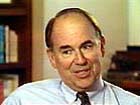
|
|
|
Access previously posted interviews. |
||
| Q:
What was Gruentzig's philosophy regarding treatment of patients? |
||
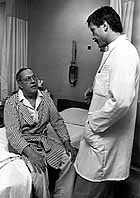 Andreas Gruentzig with patient at Emory |
Abele:
In my own mind the most significant thing he said was "I want to do
the least necessary to help the patient heal themselves". In today's
environment, where people want to replace everything and redo everything,
that's kind of a refreshing thing. You have to remember that you're
using a mechanical therapy to treat a biological problem. And you
may change the anatomy or the mechanics, but you're certainly not
changing the biology. It was, as Andreas put it, a process of producing
"controlled injury". Maybe that's a euphemism, but the way he expressed
it, I thought, was really appropriate to introducing others to what
he was trying to do.
|
|
| Q:
You've said that the invention of this device forever changed the
way new technology is viewed in medicine. Abele: Gruentzig taught that the impossible was possible. Because it was a counter-intuitive technique — the idea of putting a balloon in an artery and expanding it where you had a lesion that might fall off, an artery that might rupture — just didn't make sense. But because of his ability to measure what he was doing, as it evolved, people were able to look at much riskier things as do-able. Q: How did he measure what he was doing? |
||
| Abele:
I'm always fascinated with how do you assess new technology, particularly
in the climate of technology which is constantly changing. Not only
is the technology changing but your knowledge of anatomy, procedure
is changing, the success rate is changing, your ability to see things
is changing, your ability to use drugs, your ability to select patients
and follow-up patients is changing. How do you choose, determine when
a procedure is safe to be used widely in that environment? |
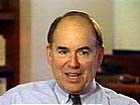 John E. Abele |
|
| He
established a way of doing that. And that was the registry concept.
And despite the fact that I think it's probably one of the most successful
complicated procedure introductions in the history of medicine, today
we've kind of reverted back, probably for legal and regulatory reasons,
to a less effective, more bureaucratic process. And hopefully we'll
dig our way out and discover, or rediscover what Gruentzig taught
so many of us. |
||
 Early "Blackboard Registry" with worldwide PTCA data |
Q:
What about the registry and its historical significance? How did it
start? Abele: When Gruentzig came over to the U.S. and did his first case with Dick Myler, which was really an experimentation in a surgery, Dick and Andreas and I talked about the idea of creating a registry to measure all this data, but instead of controlling all the variables, let them change, just document them. As a result, in the U.S., from the first case on, every case was documented in a fairly simple form. |
|
| Although
as more was learned, more data was recorded. And as it became obvious
that certain variables were necessary to understand, they were added.
In a controlled trial, you can't do that. You've got to anticipate
all the questions you need to ask before you ask them. It's logical
to see why that's good from a statistical and scientific point of
view, but it doesn't allow itself to be used in a practical sense. |
||
| So
Gruentzig and Dick Myler developed a registry form that was fairly
comprehensive and was used with every single case, no matter who was
doing it. And because the availability of catheters was very limited,
it meant they controlled people who used them and if you didn't get
the data back, then you didn't get any more catheters. So it was controlled
in that sense. This was really before the FDA was regulating devices,
aggressively, let's say. The medical device law was passed in 1976,
but it hadn't been implemented at the time of the introduction [of
PTCA]. |
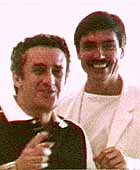 Myler & Gruentzig |
|
| That
registry lasted for eighteen months, by which time it had been reasonably
well debugged and the participants felt comfortable in the balance
of enough data to be useful, but not too much data so they couldn't
collect it. And then that's when the NIH was invited in to support
a more comprehensive one. But they basically took the one that had
been established on a voluntary basis. Q: When this first began, people in the U.S., a lot of surgeons, felt that this was still quackery. How did that turn around? Abele: The people in the U.S. who were doing the procedure were viewed as cowboys certainly. And were nowhere near as eloquent at introducing the concepts and the philosophy and the data behind it, as Gruentzig personally. 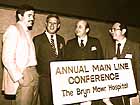 So what did accelerate its acceptance was Gruentzig personally going
around and giving hundreds of presentations. He did many grand rounds
in front of extremely hostile audiences and at the end of his presentation,
almost without exception, he would get a tremendous round of applause.
He was self-effacing, he was not aggressive, he didn't create expectations
that couldn't be met, he didn't make wild claims. He was extraordinarily
patient. He would ask questions that the cynics had not thought of
and then answer them, as well as anticipate the ones they had. He
was very patient even when they were very pointed in their questions
they asked him.
So what did accelerate its acceptance was Gruentzig personally going
around and giving hundreds of presentations. He did many grand rounds
in front of extremely hostile audiences and at the end of his presentation,
almost without exception, he would get a tremendous round of applause.
He was self-effacing, he was not aggressive, he didn't create expectations
that couldn't be met, he didn't make wild claims. He was extraordinarily
patient. He would ask questions that the cynics had not thought of
and then answer them, as well as anticipate the ones they had. He
was very patient even when they were very pointed in their questions
they asked him. |
||
| Q:
What's the state of interventional medicine today? Abele: It's the best of times today, and the worst of times in the sense that technology can do almost anything. You have cellular phones that you can hold in your hand. And you have polymers that can make catheters smaller and stronger. |
 |
|
| You
have imaging devices that can see things that were not even imagined
twenty years ago. New modalities, combined modalities, and a lot of
it is getting less expensive. So in the sense of the availability
of technology and its simplicity and even low cost, life is great. However, that has created a problem in that we have kind of a crisis of success. In the sense that we have to make choices. There are enormous cost pressures as it applies to heath care, and should be — we have to do what's appropriate, not what's possible. And how do we choose between these various things? How do we develop methods for assessing this new technology, which is advancing more and more rapidly. I also think that because of the rapid expansion of venture capital financed medical companies and the increasing involvement of physicians in those companies, there has been an unfortunate by-product — that there's been an increased tendency for hyperbole, less candor, sometimes creation of expectations that are unrealistic or unreasonable. |
||
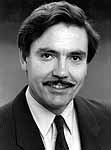 |
As
contrasted with Gruentzig where the climate could be conservative.
In fact Gruentzig was viewed as a very advanced and progressive person.
Today he'd be viewed as a very conservative and cautious person. So
that climate in my mind is unfortunate because it leads to less objectivity
rather than more. And the response from regulatory or even scientific
bodies is to create almost politically correct ways of preventing
the advancement of a lot of these technologies. |
|
Q:
Finally, what's the importance of looking back over twenty years?
What's important about this project?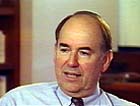 Abele: I think the importance is to examine what Gruentzig did
and understand the implications for today. And it's not simply that
Gruentzig is the person who brought us PTCA. It's that he was a person
who had us look at technology in a lot of different ways and really
understand the humanity of the technology and the implications of
how it should be used appropriately, not simply for the greatest value
to the shareholder, whether that shareholder is a holder in a managed
care institution or in a supplier of technology. That to me is a lesson
that has been dimmed, I think, in the years, particularly since his
death.
Abele: I think the importance is to examine what Gruentzig did
and understand the implications for today. And it's not simply that
Gruentzig is the person who brought us PTCA. It's that he was a person
who had us look at technology in a lot of different ways and really
understand the humanity of the technology and the implications of
how it should be used appropriately, not simply for the greatest value
to the shareholder, whether that shareholder is a holder in a managed
care institution or in a supplier of technology. That to me is a lesson
that has been dimmed, I think, in the years, particularly since his
death.This concludes our interview with John Abele. |
||
| |
||
|
Angioplasty.Org Home • PatientCenter send comments & suggestions
to "info at angioplasty dot org" |
||